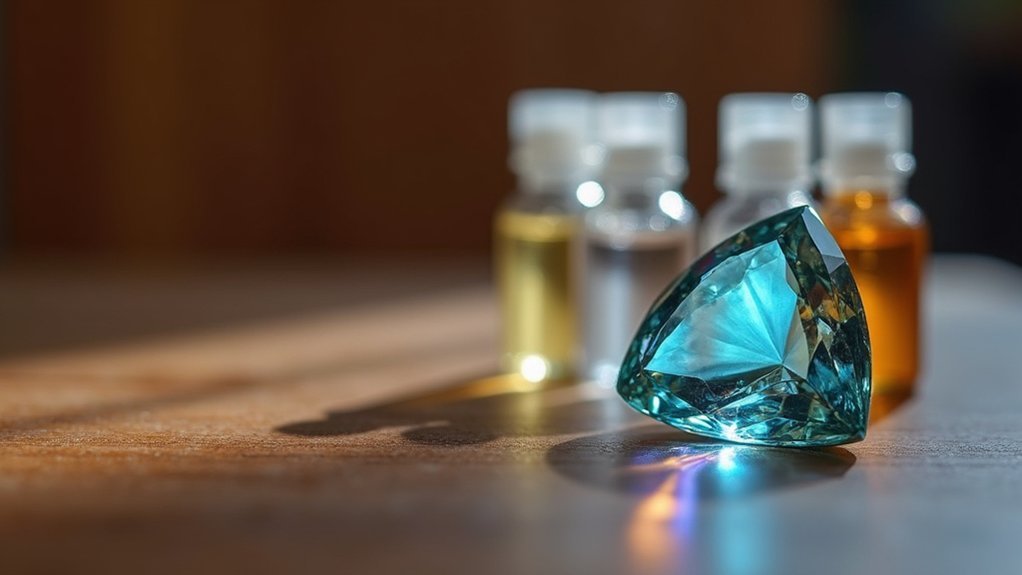You’re legally required to disclose all non-permanent gemstone treatments under FTC regulations, as failing to inform buyers constitutes deceptive trade practices. You must assess and communicate how treatments impact value—treated jade retains only 5% of natural jade’s worth. You’re also obligated to provide specific care instructions since treated stones require careful handling to prevent irreversible damage from cleaning agents like acetone. These disclosure requirements apply across all sales platforms to protect consumers and guarantee informed purchasing decisions.
Mandatory Disclosure Requirements for Non-Permanent Treatments

When you’re purchasing gemstones, sellers must disclose any non-permanent treatments that have been applied to the stones.
This disclosure requirement exists because failing to inform consumers about treatments constitutes an unfair or deceptive practice under FTC regulations. You need to know about any treatment that affects your gemstone’s value, especially when the impact is significant.
For example, treated jade like B jade (polymer impregnated) holds only 5% of natural jade’s value, making disclosure absolutely essential.
Additionally, sellers must communicate any special care requirements resulting from treatments. This guarantees you understand how to properly maintain your gemstone after purchase.
These disclosure rules apply across all sales platforms, including online transactions, protecting consumers regardless of where they buy.
Value Impact Assessment and Consumer Notification Standards
Because gemstone treatments can dramatically reduce a stone’s market value, the FTC requires sellers to assess and communicate these financial impacts to you before purchase. You must receive clear disclosure when gemstone treatments have a significant effect on pricing, particularly for treated stones like B jade that retain only 5% of natural jade’s value.
| Treatment Type | Value Impact | Required Disclosure |
|---|---|---|
| B Jade (Polymer) | 95% reduction | Mandatory |
| Dyed Jade (C/D) | 90%+ reduction | Mandatory |
| Non-permanent treatments | Variable | Required with special care instructions |
The gemstone industry operates under strict FTC regulations ensuring consumer awareness. When treatments aren’t permanent or require special care, sellers must disclose this information, enabling you to make informed decisions about your jewelry investments.
Care Instructions and Stability Warnings for Treated Gemstones

Since treated gemstones like B jade and C or D jade undergo chemical processes that compromise their structural integrity, they’ll require considerably more careful handling than their natural counterparts.
You must understand that B jade’s polymer impregnation weakens its crystalline structure, making it highly susceptible to permanent damage from cleaning agents like acetone. FTC guidelines mandate that sellers provide disclosure about these special care requirements, ensuring consumer awareness before purchase.
When handling C or D jade, you’ll need to avoid harsh chemicals that can cause deterioration. The stability of these treated gemstones is greatly compromised compared to natural jadeite.
Without proper care instructions and clear warnings about their limitations, you risk irreversible damage to these vulnerable materials.
Frequently Asked Questions
What Is the Introduction to Gem Treatments?
You’ll encounter gem treatments that modify natural or synthetic gemstones’ appearance and durability. They enhance color, clarity, or stability through processes like heat treatment, dyeing, irradiation, and fracture filling for aesthetic appeal.
What Is a Diamond Coated Gemstone?
You’re looking at a gemstone with a thin diamond layer applied through CVD or HPHT methods. This coating enhances durability and appearance, making lower-cost stones mimic natural diamonds while requiring proper disclosure.
What Is a Fracture Filling in Gemstones?
You’ll find fracture filling involves injecting transparent materials like resin into gemstone cracks to hide them and improve clarity. It’s commonly used on emeralds and diamonds but requires disclosure since it affects value.
What Is the Process of Gemstones?
You’ll witness gemstones forming deep within Earth’s crust under extreme pressure and temperature over millions of years. They’re then extracted, cut, polished for brilliance, and potentially treated to enhance their color and clarity.
In Summary
You’ll protect yourself and your business by following these three critical gem treatment disclosure laws. When you’re transparent about treatments, their permanence, and care requirements, you’re building trust with customers while avoiding legal complications. Don’t risk your reputation or face regulatory penalties—make disclosure your standard practice. Remember, informed customers make better purchasing decisions, and you’ll establish yourself as a credible dealer who prioritizes honesty and consumer protection.




Leave a Reply